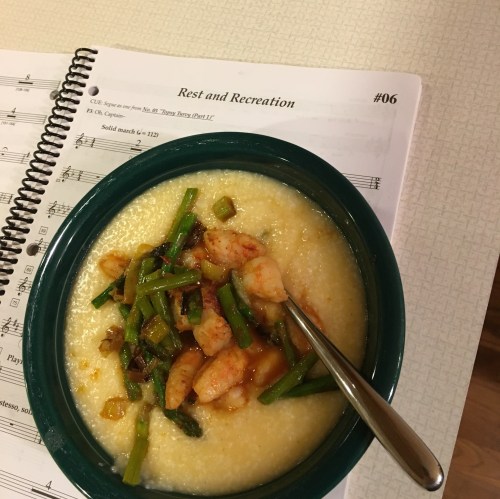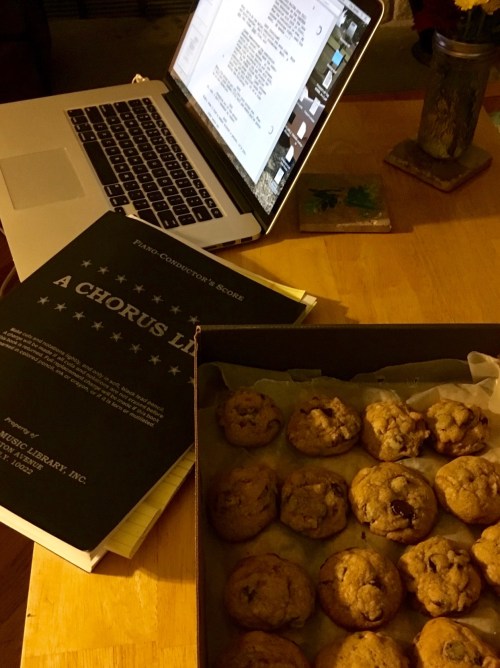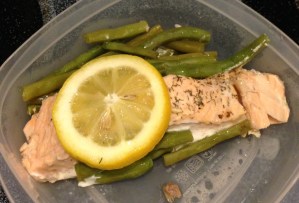 She semi-scolded me because my plans for Sunday were not exclusively recreational. Admittedly, I hadn’t had a day off between Presidents Day and my birthday in May, and then spent the next two days driving 1100 miles. That’s not to say I worked double-shifts in a factory the whole time, but I hadn’t had a day without at least one work event on the calendar. And let’s recall that I love what I do, and that most of my work is what many people would call “play.” But the rehearsal schedule here designates one full day off per week and she was a little righteously indignant that I didn’t plan to take the full day for myself. Well, sorry, I told her, but I have to be ready for tomorrow’s rehearsals, and I haven’t been willing to go without sleep for the last several nights, so I’m going to have to do some work today. She harrumphed, but recognized that I was probably right; and I assured her that at least some time during the day would be spent outside of working time.
She semi-scolded me because my plans for Sunday were not exclusively recreational. Admittedly, I hadn’t had a day off between Presidents Day and my birthday in May, and then spent the next two days driving 1100 miles. That’s not to say I worked double-shifts in a factory the whole time, but I hadn’t had a day without at least one work event on the calendar. And let’s recall that I love what I do, and that most of my work is what many people would call “play.” But the rehearsal schedule here designates one full day off per week and she was a little righteously indignant that I didn’t plan to take the full day for myself. Well, sorry, I told her, but I have to be ready for tomorrow’s rehearsals, and I haven’t been willing to go without sleep for the last several nights, so I’m going to have to do some work today. She harrumphed, but recognized that I was probably right; and I assured her that at least some time during the day would be spent outside of working time.
A lot of it was, in fact. I walked to church in beautiful sunshine, and stopped on the way home at a bakery that had been highly recommended. One placard in the display case caught my eye: Cherry Scones. I asked the clerk—whose hair was not exactly the color of cherries, but pretty close—what was in the scones. “Dried cherries,” she said, “and white chocolate chips.” “Great,” I said, and asked for a cinnamon roll. “Excellent choice!” she said. “They’re our biggest seller.” (I wonder if she secretly knew that the white chocolate chips were a bad idea.) The roll was gigantic, and gooey with frosting. It was yeasty and light, and there was probably cinnamon in there, but the very sweet frosting masked it.
I did some laundry, and since the day was beautiful and breezy (and since the weekend guests were mostly gone), hotel-hacked a way to hang it out to dry. I edited some keyboard parts.

I thought about food-prep for the week. I had a small grocery list, but nothing worth a half-hour drive to the market and back. I got a steak and some chicken thighs from my baby freezer and hotel-hacked my ice bucket as a defrosting rig while I settled back into composer-work for a while.
When the chicken was thawed, I patted it dry, seasoned some corn meal, and it it in my hot cast-iron skillet. By the time they came out the steak was ready to go in—now having similarly been patted dry, then seasoned with salt and pepper. A couple minutes on each side to sear, then seven minutes in the oven to cook more gently, and it seemed a perfect medium-rare. The skillet was still warm, and had some lovely beef juices in it, so I put it back on the stove. I sliced an onion and the last few mushrooms in the veggie bin and sautéed them to have with the steak.
Protein accounted for, I edited a bunch more pages of keyboard parts. I thought about my still-warm oven. Scones. My alter-ego Cherry Pandowdy had thoughtfully provided self-rising flour, and I had a bag of dried cherries and half a bar of dark chocolate. Even if I use the rest of the eggs, I thought, I’ve already had breakfast. I looked around for scone recipes. Cooking is jazz, a composer friend of mine likes to say, but baking is classical—I needed a score to follow.
I found recipe after recipe that called for baking powder—even the ones that used self-rising flour. Finally I found one. It seemed a little wacky, asking that the wet and dry ingredients be mixed in a Ziploc bag, but the rest of the ingredient list was one I could handle. Except that all the measurements were metric. “Hey, Siri,” I called. My phone chirped to life. “Convert 200 grams of flour to cups.” She told me (1.67). I thanked her, and she responded, “It’s nice to be appreciated.” Our “conversation” continued as I got the right amounts of butter and sugar and salt. I figured I’d take my chances with the called-for “a splash of milk” and “one egg.” I rehydrated the dried cherries just a bit in a splash of red wine (because why not) and chopped the chocolate. I cut the butter into the dry ingredients with a fork and my fingers, working as quickly as I could so as not to develop too much gluten. The recipe hadn’t given me a good reason to use the Ziploc method, so I threw in a little jazz. I mixed in the chocolate and cherries, then turned the dough out onto my floured cutting board (which, yes, had been washed and dried and washed and dried, and washed and dried again since the chicken, steak, mushrooms, and onions), dusted it with a little more flour, patted as lightly as I could, and cut the dough into six wedges that fit neatly into my cast-iron do-everything pan. “Hey, Siri, one more thing—convert 200 degrees Celsius to Fahrenheit.” I didn’t have an oven thermometer (I’m camping!) so set the not-so-finely-calibrated oven knob to a bit under 400 and hoped for the best.

Are these the best scones ever? No. They’re a little heavier than the ones I make with baking powder, but they’re not bricks. And they have the right proportion of cherry to everything else. Dark chocolate is exactly what I wanted. And now breakfast is accounted for. While the scones cooled I went back to editing.

I took myself out for a late afternoon run, edited more pages while I cooled down, showered, edited a few more pages, drove toward the market and found a place to get a bite of dinner while reading a play that I’ll be working on later this summer. The market was closed by the time I got back to it, but no worries. I’ll get salad greens and eggs—and baking powder—another time.
She and I talked on the phone for a while, she sent me photos of the outfit she planned for a gala work event. I heartily approved!

And then it was time for her to head for bed and me back to work. I had a rehearsal to get ready for.
A day off? Not quite. Well-spent? Definitely.





 I’m working on a production
I’m working on a production 















